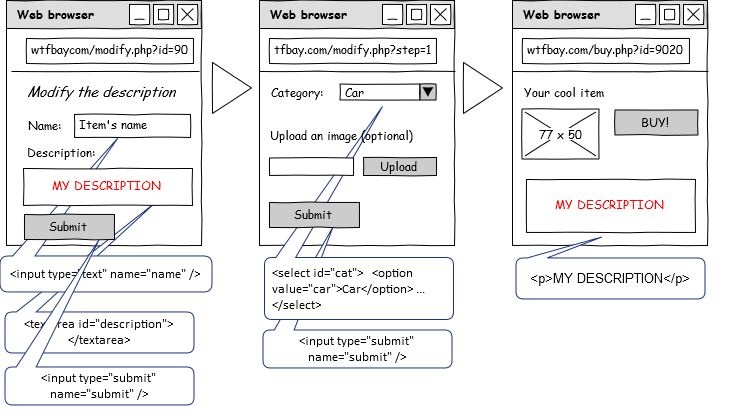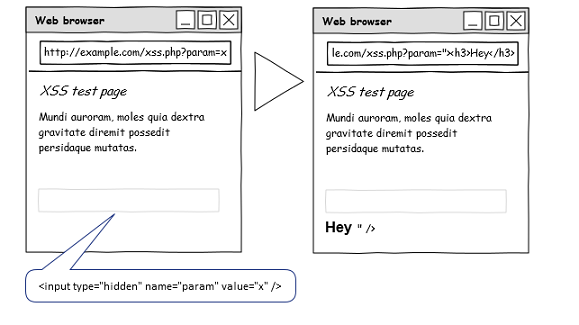Snuck is a Selenium based automated tool programmed, which is different from typical web security scanners, to help discovered XSS vulnerabilities in web applications. It's approach is related to the inspection of the injection's reflection context, specialising them in order to increase the success rate of breaking a given XSS filter. The attack vectors are chosen on the basis of the reflection context (the pinpointed location where the injection falls in the reflection web page's DOM). This is possible through Selenium web driver that allows to duplicate operations in web browsers. It requires an XML configuration file to be filled in order to make snuck a wiz at what it needs to do with respect to the test web application. It supports Mozilla Firefox, Google Chrome and Internet Explorer and the XSS testing in performed on a real web browser to mirror the attacker's and (possibly) the victim's behaviour.
Snuck is a Java-based open-source software and is released under the Apache 2.0 license. To download you can use the following source using snv:
svn checkout http://snuck.googlecode.com/svn/trunk/ snuck-read-only
Once done, you can use the build.xml for Ant to compile the source files and generate the jar file
cd snuck-read-only
ant jar
Then you will be able to generate an executable jar file which is ready to run.
You can also download it via a ready-to-run executable jar by click here.
We would like to mention here that you just need a working JVM and Firefox to run this software. To run a test with Google Chrome/Chromium, you must download and use the appropriate server which is a bridge between the web browser and the driver.
To run the software on Internet Explorer and its appropriate server please refer to the following link.
You will also need to familiarise yourself with the command line options. Below you can find the available arguments and the correspondent description:
>java -jar snuck.jarUsage: snuck [-start xmlconfigfile ] -config xmlconfigfile -report htmlreportfile [-d # ms_delay]
[-proxy IP:port] [-chrome chromedriver ] [-ie iedriver] [-remotevectors URL] [-stop-first]
[-reflected targetURL -p parameter_toTest] [-no-multi]
Options :
-start path to login use case (XML file)
-config path to injection use case (XML file)
-report report file name (html extension is required)
-d delay (ms) between each injection
-proxy proxy server (IP: port)
-chrome perform a test with Google Chrome, instead of Firefox. It needs the path to the chromedriver
-ie perform a test with Internet Explorer, instead of Firefox.
Disable the built in XSS filter in advance
-remotevectors use an up-to-date online attack vectors source instead of the local one
-stop-first stop the test upon a successful vector is detected
-no-multi deactivate multithreading for the reverse engineering process - a sequential approach will be adopted
-reflected perform a reflected XSS test (without writing the XML config file)
-p HTTP GET parameter to inject (useful if -reflected is setted)
-help show this help menu
Sample Scenarios and How-Tos According to Google:
- Scenario I: Stored XSS
- Let us assume to have an e-commerce web site, which allows sellers to modify the description of their items. Items' descriptions are publicly accessible, thus leading to stored XSS in the case of XSS filter bugs. Testing the XSS filter needs three steps to be performed before landing in the reflection page. Since the injection is reflected within a P html element, the tool will reverse the fi lter and report the allowed tags and attributes in the final report. Obviously detected XSS are reported as well. See the following image for better understanding the context.
In the aforementioned case snuck need to know which operations are required to connect the injection page, that is the web page in which the malicious payload is supplied, to the reflection one, that is the web page in which the payload is reflected. This task can be done by passing an XML configuration file, such as the following. In particular every <command> reports a tuple in the form of Selenium commands, refer to Selenium selectors for further information.
In addition, since it is obvious that a login operation is required for managing our items, then another XML configuration file is needed.<?xml version="1.0" encoding="UTF-8"?>
<root>
<post>
<commands>
<command>
<name>open</name>
<target>http://wtfbay.com/modify.php?id=90</target>
<value></value>
</command>
<command>
<name>type</name>
<target>name=name</target>
<value>${RANDOM}</value>
</command>
<command>
<name>type</name>
<target>id=description</target>
<value>${INJECTION}</value>
</command>
<command>
<name>click</name>
<target>name=submit</target>
<value></value>
</command>
<command>
<name>select</name>
<target>id=cat</target>
<value>Bike</value>
</command>
<command>
<name>click</name>
<target>name=submit</target>
<value></value>
</command>
</commands>
</post>
</root>
So far so good, now, how can we start the tool? By assuming that we want an HTML report named report.html and the aforepresented XML files are named usecase.xml and login.xml, then:<?xml version="1.0" encoding="UTF-8"?>
<root>
<post>
<commands>
<command>
<name>open</name>
<target>http://wtfbay.com/login.php</target>
<value></value>
</command>
<command>
<name>type</name>
<target>name=user</target>
<value>admin</value>
</command>
<command>
<name>type</name>
<target>name=pwd</target>
<value>admin</value>
</command>
<command>
<name>click</name>
<target>name=submit</target>
<value></value>
</command>
</commands>
</post>
</root>
> java -jar snuck.jar -config usecase.xml -report report.html -start login.xml
What will the tool do? Basically the tool will firstly reverse engineer the HTML filter used against the user-supplied description, then it will start injecting multiple attack vectors and check whether an XSS is triggered - the important point here is that alert dialog windows are grabbed in order to decide whether an injection is successful; this means that false positive rate is equal to 0 as a vulnerability is reported just in case an alert dialog window is grabbed by the used web browser (note that this is automatically performed).
- Scenario II: Stored XSS Let us assume to have a blog, which allows visitors to leave comments. As in the previous case, our goal is to bypass the filter the web application is using against user generated content. Since the tool just need to fill some field and perform the attack, this is actually comparable to a fuzzy approach. See the following image for better understanding the context:.
<?xml version="1.0" encoding="UTF-8"?>
<root>
<post>
<parameters>
<parameter>
<name>username</name>
<value>hal9001</value>
</parameter>
</parameters>
<commands>
<command>
<name>open</name>
<target>http://examplecom/post.php?id=90</target>
<value></value>
</command>
<command>
<name>type</name>
<target>name=name</target>
<value>${USERNAME}</value>
</command>
<command>
<name>type</name>
<target>id=comment</target>
<value>${INJECTION}</value>
</command>
<command>
<name>click</name>
<target>name=submit</target>
<value></value>
</command>
</commands>
</post>
</root>java -jar snuck.jar -config usecase.xml -report report.html
The remarkable points here are that variables can be defined through the <parameter> tags and referenced by using strings in the form of ${variable_name}. In addition you can use ${RANDOM} or ${RANDOM_EMAIL} within <value> tags for asking the tool to supply a random alphanumeric string or a random email.
- Scenario III: Reflected XSS Here we present a basic scenario in which the value of an HTTP GET parameter is reflected in a web page, in particular in the attribute value of an input element, whose type is setted to hidden. As usual, we want to test whether injecting this parameter could result in a reflected XSS vulnerability - see below for the XML configuration file and how it is possible to start snuck - in this case we have two different opportunities.
<?xml version="1.0" encoding="UTF-8"?>
<root>
<get>
<parameters>
<targeturl>http://example.com/xss.php</targeturl>
<reflectionurl></reflectionurl>
<paramtoinject>param</paramtoinject>
<parameter>foo=bar</parameter>
</parameters>
</get>
</root>> java -jar snuck.jar -config config.xml -report report.html# faster mode (no XML file required)
> java -jar snuck.jar -report report.html -reflected "http://example.com/xss.php?foo=bar" -p param
Note that the <reflectionurl> can be used for asking the tool to make the injections at <targeturl> and to look for reflections at the URL defined with <reflectionurl>.
Further information Sometimes it might be useful to discover the first successful injection without realizing a complete test. This task could be achieved through the argument -stop-first, which makes the tool stop at the first positive, it will find. In addition, you could obviously stop the test through CTRL+C, if so, then the tool will print in stdout the successful injections that it found so far.
Click on this link to download Snuck.
Cheers!
About The Author
This article is written by Sindhia Javed Junejo. She is one of the core members of RHA team.
This article is written by Sindhia Javed Junejo. She is one of the core members of RHA team.















No comments:
Post a Comment